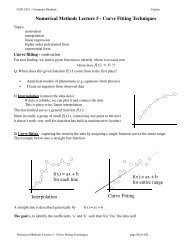1 Introduction
1 Introduction
1 Introduction
- No tags were found...
Create successful ePaper yourself
Turn your PDF publications into a flip-book with our unique Google optimized e-Paper software.
1.2. Probability Theory 211.2.3 Bayesian probabilitiesSo far in this chapter, we have viewed probabilities in terms of the frequenciesof random, repeatable events. We shall refer to this as the classical or frequentistinterpretation of probability. Now we turn to the more general Bayesian view, inwhich probabilities provide a quantification of uncertainty.Consider an uncertain event, for example whether the moon was once in its ownorbit around the sun, or whether the Arctic ice cap will have disappeared by the endof the century. These are not events that can be repeated numerous times in orderto define a notion of probability as we did earlier in the context of boxes of fruit.Nevertheless, we will generally have some idea, for example, of how quickly wethink the polar ice is melting. If we now obtain fresh evidence, for instance from anew Earth observation satellite gathering novel forms of diagnostic information, wemay revise our opinion on the rate of ice loss. Our assessment of such matters willaffect the actions we take, for instance the extent to which we endeavour to reducethe emission of greenhouse gasses. In such circumstances, we would like to be ableto quantify our expression of uncertainty and make precise revisions of uncertainty inthe light of new evidence, as well as subsequently to be able to take optimal actionsor decisions as a consequence. This can all be achieved through the elegant, and verygeneral, Bayesian interpretation of probability.The use of probability to represent uncertainty, however, is not an ad-hoc choice,but is inevitable if we are to respect common sense while making rational coherentinferences. For instance, Cox (1946) showed that if numerical values are used torepresent degrees of belief, then a simple set of axioms encoding common senseproperties of such beliefs leads uniquely to a set of rules for manipulating degrees ofbelief that are equivalent to the sum and product rules of probability. This providedthe first rigorous proof that probability theory could be regarded as an extension ofBoolean logic to situations involving uncertainty (Jaynes, 2003). Numerous otherauthors have proposed different sets of properties or axioms that such measures ofuncertainty should satisfy (Ramsey, 1931; Good, 1950; Savage, 1961; deFinetti,1970; Lindley, 1982). In each case, the resulting numerical quantities behave preciselyaccording to the rules of probability. It is therefore natural to refer to thesequantities as (Bayesian) probabilities.In the field of pattern recognition, too, it is helpful to have a more general no-Thomas Bayes1701–1761Thomas Bayes was born in TunbridgeWells and was a clergymanas well as an amateur scientist anda mathematician. He studied logicand theology at Edinburgh Universityand was elected Fellow of theRoyal Society in 1742. During the 18 th century, issuesregarding probability arose in connection withgambling and with the new concept of insurance. Oneparticularly important problem concerned so-called inverseprobability. A solution was proposed by ThomasBayes in his paper ‘Essay towards solving a problemin the doctrine of chances’, which was published in1764, some three years after his death, in the PhilosophicalTransactions of the Royal Society. In fact,Bayes only formulated his theory for the case of a uniformprior, and it was Pierre-Simon Laplace who independentlyrediscovered the theory in general form andwho demonstrated its broad applicability.





